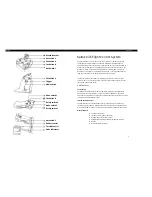
Troubleshooting
January 2023
•
Rev. 0
• Standard Devices User Manual
36
Troubleshooting
If you run into trouble with installation or operation, get in touch with support (
General Use
Issue:
The buttons do not work, and the screen
shows
LCK
.
Action:
The flow controller buttons were locked out via
a serial command (
unit_id
L
). Press and hold
all four outer buttons to unlock the interface.
Issue:
I can’t read the display easily.
Action:
During the day, you can increase the visibility
of the display by increasing the contrast or
brightness (
). For monochrome
displays under low-light conditions, push the
bottom central button (located below the display)
to turn on the backlight.
Issue:
The analog output signal indicates values
lower than what appears on my instrument’s
display.
Action:
Analog signal voltage degrades over long
distances. You can minimize this effect by using
wires with a heavier gauge, especially in the
ground wire.
Issue:
How often do I need to calibrate my device?
Action:
Annual recalibration is recommended. Check
your device’s last calibration date by selecting
MENU
→
ABOUT
→
About Device
. If it is time
to recalibrate, request a recalibration from
customer support (
Issue:
I dropped my device. Is it OK? Do I need to
recalibrate?
Action:
If it turns on and appears to respond normally,
then it is probably OK. It may or may not need
a recalibration. Give it a tare (
), and
compare it against a known good flow standard.
If it checks out, keep using it, but tell us about
the drop at your next annual recalibration so we
can check it out for you.
Issue:
How can I see readings in different units?
Action:
From the main menu, select
SETUP
→
Sensor
→
Engineering Units
. From this menu, you can
adjust any variable’s units. For more information,
see
Issue:
My controller won’t reach its setpoint.
Action:
This is often caused by not enough supply
pressure in the system. Increasing the inlet
pressure regularly fixes this issue.
If increasing the pressure doesn’t help, check to
see if there is a clog. Teflon tape can often get
stuck in the flow channel and block flow. Clean
out any loose Teflon tape and never tape the first
two threads entering the device to help avoid
this issue.
Flow Readings
Issue:
The live flow readings won’t settle down.
Action:
The device is very fast, so it can detect subtle
variations in flow that may go unnoticed by your
other devices. This sensitivity can help detect
problems with pumps or flow controllers. You
can lessen this sensitivity by increasing the
flow averaging (
).
Controllers use
PD or PD²I control loop algorithms to reach the
setpoint given. These parameters are adjustable
in the field. See
for a quick guide on
tuning.
Issue:
My flow readings are negative.
Action:
Set a zero setpoint to see if the flow returns to 0
after 2 seconds. Under conditions of no flow, a
negative flow reading can indicate a poor tare.
If using a controller, ensure that auto tare is
enabled and give the controller a zero setpoint
for at least 2 seconds.
Issue:
My device does not agree with another flow
device I have in line.
Action:
Check the STP or NTP settings (
MENU
→
SETUP
→
Sensor
→
STP
/
NTP
Flow
Ref
) to ensure that
your standardized temperature and pressure
references match those of your other flow
calibrator. Also check that your device’s Gas
Select™ is set to the right gas or mixture.
Issue:
My flow readings won’t change when flow
changes.
Action:
If your flow readings won’t change regardless of
actual flow, your flow sensor may be damaged.
Please contact support to troubleshoot
(
).












































